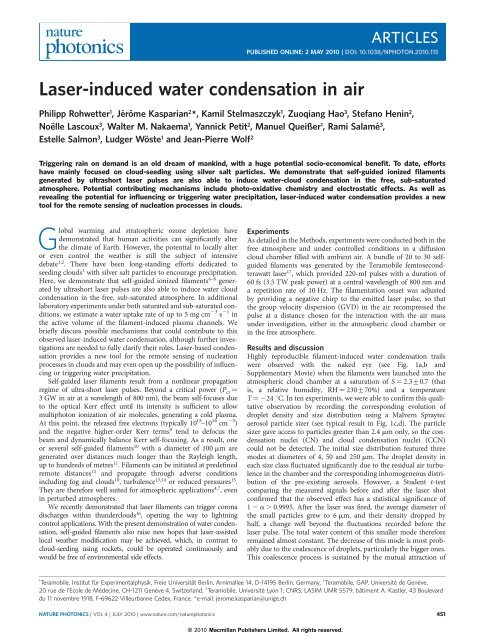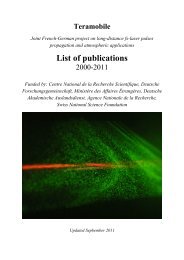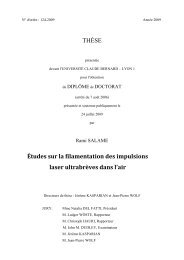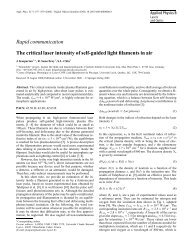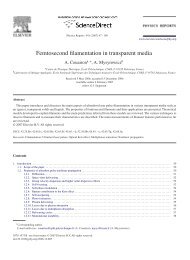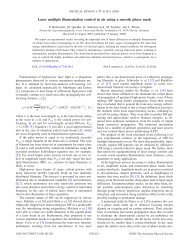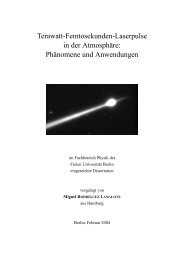Laser-induced water condensation in air - teramobile
Laser-induced water condensation in air - teramobile
Laser-induced water condensation in air - teramobile
You also want an ePaper? Increase the reach of your titles
YUMPU automatically turns print PDFs into web optimized ePapers that Google loves.
ARTICLES<br />
PUBLISHED ONLINE: 2 MAY 2010 | DOI: 10.1038/NPHOTON.2010.115<br />
<strong>Laser</strong>-<strong><strong>in</strong>duced</strong> <strong>water</strong> <strong>condensation</strong> <strong>in</strong> <strong>air</strong><br />
Philipp Rohwetter 1 ,Jérôme Kasparian 2 *, Kamil Stelmaszczyk 1 , Zuoqiang Hao 3 , Stefano Hen<strong>in</strong> 2 ,<br />
Noëlle Lascoux 3 , Walter M. Nakaema 1 ,YannickPetit 2 , Manuel Queißer 1 , Rami Salamé 3 ,<br />
Estelle Salmon 3 , Ludger Wöste 1 and Jean-Pierre Wolf 2<br />
Trigger<strong>in</strong>g ra<strong>in</strong> on demand is an old dream of mank<strong>in</strong>d, with a huge potential socio-economical benefit. To date, efforts<br />
have ma<strong>in</strong>ly focused on cloud-seed<strong>in</strong>g us<strong>in</strong>g silver salt particles. We demonstrate that self-guided ionized filaments<br />
generated by ultrashort laser pulses are also able to <strong>in</strong>duce <strong>water</strong>-cloud <strong>condensation</strong> <strong>in</strong> the free, sub-saturated<br />
atmosphere. Potential contribut<strong>in</strong>g mechanisms <strong>in</strong>clude photo-oxidative chemistry and electrostatic effects. As well as<br />
reveal<strong>in</strong>g the potential for <strong>in</strong>fluenc<strong>in</strong>g or trigger<strong>in</strong>g <strong>water</strong> precipitation, laser-<strong><strong>in</strong>duced</strong> <strong>water</strong> <strong>condensation</strong> provides a new<br />
tool for the remote sens<strong>in</strong>g of nucleation processes <strong>in</strong> clouds.<br />
Global warm<strong>in</strong>g and stratospheric ozone depletion have<br />
demonstrated that human activities can significantly alter<br />
the climate of Earth. However, the potential to locally alter<br />
or even control the weather is still the subject of <strong>in</strong>tensive<br />
debate 1,2 . There have been long-stand<strong>in</strong>g efforts dedicated to<br />
seed<strong>in</strong>g clouds 3 with silver salt particles to encourage precipitation.<br />
Here, we demonstrate that self-guided ionized filaments 4–8 generated<br />
by ultrashort laser pulses are also able to <strong>in</strong>duce <strong>water</strong> cloud<br />
<strong>condensation</strong> <strong>in</strong> the free, sub-saturated atmosphere. In additional<br />
laboratory experiments under both saturated and sub-saturated conditions,<br />
we estimate a <strong>water</strong> uptake rate of up to 5 mg cm 23 s 21 <strong>in</strong><br />
the active volume of the filament-<strong><strong>in</strong>duced</strong> plasma channels. We<br />
briefly discuss possible mechanisms that could contribute to this<br />
observed laser-<strong><strong>in</strong>duced</strong> <strong>water</strong> <strong>condensation</strong>, although further <strong>in</strong>vestigations<br />
are needed to fully clarify their roles. <strong>Laser</strong>-based <strong>condensation</strong><br />
provides a new tool for the remote sens<strong>in</strong>g of nucleation<br />
processes <strong>in</strong> clouds and may even open up the possibility of <strong>in</strong>fluenc<strong>in</strong>g<br />
or trigger<strong>in</strong>g <strong>water</strong> precipitation.<br />
Self-guided laser filaments result from a nonl<strong>in</strong>ear propagation<br />
regime of ultra-short laser pulses. Beyond a critical power (P cr ¼<br />
3 GW <strong>in</strong> <strong>air</strong> at a wavelength of 800 nm), the beam self-focuses due<br />
to the optical Kerr effect until its <strong>in</strong>tensity is sufficient to allow<br />
multiphoton ionization of <strong>air</strong> molecules, generat<strong>in</strong>g a cold plasma.<br />
At this po<strong>in</strong>t, the released free electrons (typically 10 15 –10 16 cm 23 )<br />
and the negative higher-order Kerr terms 9 tend to defocus the<br />
beam and dynamically balance Kerr self-focus<strong>in</strong>g. As a result, one<br />
or several self-guided filaments 10 with a diameter of 100 mm are<br />
generated over distances much longer than the Rayleigh length,<br />
up to hundreds of metres 11 . Filaments can be <strong>in</strong>itiated at predef<strong>in</strong>ed<br />
remote distances 12 and propagate through adverse conditions<br />
<strong>in</strong>clud<strong>in</strong>g fog and clouds 10 , turbulence 13,14 or reduced pressures 15 .<br />
They are therefore well suited for atmospheric applications 4,7 ,even<br />
<strong>in</strong> perturbed atmospheres.<br />
We recently demonstrated that laser filaments can trigger corona<br />
discharges with<strong>in</strong> thunderclouds 16 , open<strong>in</strong>g the way to lightn<strong>in</strong>g<br />
control applications. With the present demonstration of <strong>water</strong> <strong>condensation</strong>,<br />
self-guided filaments also raise new hopes that laser-assisted<br />
local weather modification may be achieved, which, <strong>in</strong> contrast to<br />
cloud-seed<strong>in</strong>g us<strong>in</strong>g rockets, could be operated cont<strong>in</strong>uously and<br />
would be free of environmental side effects.<br />
Experiments<br />
As detailed <strong>in</strong> the Methods, experiments were conducted both <strong>in</strong> the<br />
free atmosphere and under controlled conditions <strong>in</strong> a diffusion<br />
cloud chamber filled with ambient <strong>air</strong>. A bundle of 20 to 30 selfguided<br />
filaments was generated by the Teramobile femtosecondterawatt<br />
laser 17 , which provided 220-mJ pulses with a duration of<br />
60 fs (3.5 TW peak power) at a central wavelength of 800 nm and<br />
a repetition rate of 10 Hz. The filamentation onset was adjusted<br />
by provid<strong>in</strong>g a negative chirp to the emitted laser pulse, so that<br />
the group velocity dispersion (GVD) <strong>in</strong> the <strong>air</strong> recompressed the<br />
pulse at a distance chosen for the <strong>in</strong>teraction with the <strong>air</strong> mass<br />
under <strong>in</strong>vestigation, either <strong>in</strong> the atmospheric cloud chamber or<br />
<strong>in</strong> the free atmosphere.<br />
Results and discussion<br />
Highly reproducible filament-<strong><strong>in</strong>duced</strong> <strong>water</strong> <strong>condensation</strong> trails<br />
were observed with the naked eye (see Fig. 1a,b and<br />
Supplementary Movie) when the filaments were launched <strong>in</strong>to the<br />
atmospheric cloud chamber at a saturation of S ¼ 2.3+0.7 (that<br />
is, a relative humidity, RH ¼ 230+70%) and a temperature<br />
T ¼ 224 8C. In ten experiments, we were able to confirm this qualitative<br />
observation by record<strong>in</strong>g the correspond<strong>in</strong>g evolution of<br />
droplet density and size distribution us<strong>in</strong>g a Malvern Spraytec<br />
aerosol particle sizer (see typical result <strong>in</strong> Fig. 1c,d). The particle<br />
sizer gave access to particles greater than 2.4 mm only, so the <strong>condensation</strong><br />
nuclei (CN) and cloud <strong>condensation</strong> nuclei (CCN)<br />
could not be detected. The <strong>in</strong>itial size distribution featured three<br />
modes at diameters of 4, 50 and 250 mm. The droplet density <strong>in</strong><br />
each size class fluctuated significantly due to the residual <strong>air</strong> turbulence<br />
<strong>in</strong> the chamber and the correspond<strong>in</strong>g <strong>in</strong>homogeneous distribution<br />
of the pre-exist<strong>in</strong>g aerosols. However, a Student t-test<br />
compar<strong>in</strong>g the measured signals before and after the laser shot<br />
confirmed that the observed effect has a statistical significance of<br />
1 2 a . 0.9995. After the laser was fired, the average diameter of<br />
the small particles grew to 6 mm, and their density dropped by<br />
half, a change well beyond the fluctuations recorded before the<br />
laser pulse. The total <strong>water</strong> content of this smaller mode therefore<br />
rema<strong>in</strong>ed almost constant. The decrease of this mode is most probably<br />
due to the coalescence of droplets, particularly the bigger ones.<br />
This coalescence process is susta<strong>in</strong>ed by the mutual attraction of<br />
1<br />
Teramobile, Institut für Experimentalphysik, Freie Universität Berl<strong>in</strong>, Arnimallee 14, D-14195 Berl<strong>in</strong>, Germany, 2 Teramobile, GAP, Université de Genève,<br />
20 rue de l’Ecole de Médec<strong>in</strong>e, CH-1211 Genève 4, Switzerland, 3 Teramobile, Université Lyon 1; CNRS; LASIM UMR 5579, bâtiment A. Kastler, 43 Boulevard<br />
du 11 novembre 1918, F-69622 Villeurbanne Cedex, France. *e-mail: jerome.kasparian@unige.ch<br />
NATURE PHOTONICS | VOL 4 | JULY 2010 | www.nature.com/naturephotonics 451<br />
© 2010 Macmillan Publishers Limited. All rights reserved.
ARTICLES<br />
NATURE PHOTONICS DOI: 10.1038/NPHOTON.2010.115<br />
a<br />
b<br />
5 mm<br />
5 mm<br />
c<br />
Droplet density (cm 3 /size class)<br />
10 3<br />
100<br />
10<br />
1<br />
0.1<br />
10 −2<br />
10 −3<br />
10 −4<br />
Time relative to laser pulse (s)<br />
5<br />
4<br />
3<br />
2<br />
1<br />
0<br />
−1<br />
d<br />
Droplet density (cm −3 )<br />
1,600<br />
1,200<br />
800<br />
400<br />
Total condensed mass<br />
Small droplets (
NATURE PHOTONICS DOI: 10.1038/NPHOTON.2010.115<br />
a<br />
Normalized counts<br />
b<br />
Mean normalized counts<br />
1.0<br />
0.8<br />
0.6<br />
0.4<br />
0.2<br />
0.0<br />
0<br />
0.5<br />
0.4<br />
0.3<br />
0.2<br />
0.1<br />
500<br />
Time (s)<br />
<strong>Laser</strong> ON time<br />
Scatter<strong>in</strong>g signal<br />
1,000<br />
<strong>Laser</strong> shot no.<br />
1 50 100 150 200 250 300<br />
Exponential fit, = 4 s<br />
Background<br />
0.0<br />
0 5 10 15 20 25 30<br />
Time after first shot (s)<br />
Figure 2 | <strong>Laser</strong>-<strong><strong>in</strong>duced</strong> <strong>condensation</strong> <strong>in</strong> a sub-saturated atmospheric<br />
cloud chamber (T 5 60 8C, RH 5 75–85%), observed through the<br />
scattered signal at 908. a, High reproducibility of the effect over repeated<br />
laser on/off cycles of 300 laser shots each. b, Rise time (time constant<br />
t ≈ 4 s) of the light scattered by the grow<strong>in</strong>g droplets, averaged over the 17<br />
cycles of panel a.<br />
This negligible heat<strong>in</strong>g of the <strong>air</strong> contrasts with the high electron<br />
temperature <strong>in</strong> the plasma filament, which can reach up to<br />
6,000 K (refs 5–8). It should be noted that, due to the small transverse<br />
dimension of the filaments, the slight local heat<strong>in</strong>g of the <strong>air</strong><br />
results <strong>in</strong> large temperature gradients, lead<strong>in</strong>g to the development<br />
of a shockwave 21 . The correspond<strong>in</strong>g expansion of the <strong>air</strong> might<br />
contribute to the <strong>condensation</strong> process.<br />
Note also that the fragmentation of pre-exist<strong>in</strong>g <strong>water</strong> droplets<br />
<strong>in</strong>to smaller ones <strong>in</strong>creases the scatter<strong>in</strong>g signal. We quantified<br />
this effect by modell<strong>in</strong>g the laser-<strong><strong>in</strong>duced</strong> droplet fragmentation,<br />
consider<strong>in</strong>g that each mother droplet absorbs an amount of<br />
energy proportional to its cross-section, part of which is turned<br />
<strong>in</strong>to additional surface energy dur<strong>in</strong>g fragmentation. A one-step<br />
fragmentation model based on a maximum entropy pr<strong>in</strong>ciple<br />
results <strong>in</strong> a Poissonian size distribution of the fragments of each<br />
mother droplet 22 . By treat<strong>in</strong>g this distribution as cont<strong>in</strong>uous, even<br />
<strong>in</strong> cases where it conta<strong>in</strong>ed only a few tens of daughter particles 23 ,<br />
we found that the contribution of laser-<strong><strong>in</strong>duced</strong> droplet fragmentation<br />
to the effect observed <strong>in</strong> the sub-saturated cloud chamber was<br />
marg<strong>in</strong>al, regardless of whether nonl<strong>in</strong>ear absorption or l<strong>in</strong>ear<br />
absorption were considered. Instead, the observed <strong>condensation</strong><br />
may be understood by remember<strong>in</strong>g that the atmospheric cloud<br />
chamber is filled with ambient <strong>air</strong>. Therefore, <strong>in</strong> the urban<br />
environment of the laboratory (<strong>in</strong>clud<strong>in</strong>g aerosols and gaseous<br />
pollutants) and <strong>in</strong> the presence of the high-<strong>in</strong>tensity laser<br />
field, photochemically or charge-assisted mechanisms contribute<br />
significantly to droplet formation 24–26 .<br />
To provide a def<strong>in</strong>itive demonstration of the capability of laser<br />
filaments to trigger <strong>condensation</strong>, not only <strong>in</strong> controlled laboratory<br />
conditions but also <strong>in</strong> real atmospheric conditions, we performed<br />
open-field experiments (Fig. 3a) <strong>in</strong> the late autumn of 2008 <strong>in</strong><br />
Berl<strong>in</strong>, Germany, under conditions of polar <strong>air</strong> mass, provid<strong>in</strong>g a<br />
high relative humidity (RH ¼ 90–93%) together with low level of<br />
background aerosols (70 km horizontal visibility). The laser was<br />
launched vertically <strong>in</strong>to the atmosphere, at a repetition rate of<br />
5 Hz. The filaments were most active between heights of 45 and<br />
75 m. Their strength then decreased over a few tens of metres<br />
beyond this range. The aerosol content of the atmosphere was monitored<br />
by LIDAR (light detection and rang<strong>in</strong>g) 27 us<strong>in</strong>g a low-power<br />
frequency-doubled Nd:YAG laser at 10 Hz repetition rate. This<br />
allowed the performance of differential measurements of the<br />
changes <strong><strong>in</strong>duced</strong> by the terawatt laser pulses preced<strong>in</strong>g the LIDAR<br />
pulses (Fig. 3a). The LIDAR return signals provide range-resolved<br />
measurements of the total volume backscatter<strong>in</strong>g coefficient b,<br />
which comprises a molecular contribution (Rayleigh scatter<strong>in</strong>g is<br />
subtracted <strong>in</strong> the data process<strong>in</strong>g) and an aerosol contribution<br />
(Mie scatter<strong>in</strong>g). This aerosol backscatter<strong>in</strong>g coefficient b Mie is<br />
def<strong>in</strong>ed as 27 ds n, r<br />
b Mie = Nr () ( )<br />
dV ∣ dr (1)<br />
u=p<br />
∫ 1<br />
0<br />
ARTICLES<br />
where N(r) is the number density of droplets of size r, and<br />
ds( n, r)/dV ∣ u=p<br />
is the size- and refractive <strong>in</strong>dex-dependent backscatter<strong>in</strong>g<br />
differential cross-section of the particles. b Mie therefore provides<br />
<strong>in</strong>formation averaged over all aerosol types and sizes with<strong>in</strong><br />
the probed volume.<br />
The LIDAR measurements were taken 1 ms after fir<strong>in</strong>g the terawatt<br />
laser pulses. This time delay, much shorter than typical droplet<br />
growth times, was imposed by a lateral w<strong>in</strong>d sweep<strong>in</strong>g the <strong>air</strong><br />
ionized by the filaments out of the detection volume. As already<br />
mentioned above, the filaments occupy a fraction of only 2.5 × 10 24<br />
of the <strong>air</strong> volume probed by the LIDAR. Despite those difficulties<br />
and atmospheric fluctuations, the beam-averaged value of b Mie at<br />
the height of the filaments was up to 0.5% higher when follow<strong>in</strong>g a<br />
filament<strong>in</strong>g laser pulse than without filaments (Fig. 3b). This<br />
<strong>in</strong>crease corresponds to a local enhancement of Mie scatter<strong>in</strong>g by a<br />
factor of 20 with<strong>in</strong> the filaments, from b Mie ¼ 1 × 10 26 m 21 sr 21 to<br />
2 × 10 25 m 21 sr 21 . The latter value is typical of haze 27 ,<strong>in</strong>spiteofa<br />
growth time of 1 ms, much shorter than the signal rise time identified<br />
<strong>in</strong> the sub-saturated chamber (Fig. 2b). Because b Mie is a measure of all<br />
k<strong>in</strong>ds of aerosols, one could argue that only sulphate and nitrate CN or<br />
CCN were observed. However, the results of the experiment <strong>in</strong> the<br />
sub-saturated chamber discussed above show that the laser filaments<br />
also cause the subsequent <strong>condensation</strong> of <strong>water</strong> droplets provided<br />
enough <strong>water</strong> vapour is available <strong>in</strong> the atmosphere.<br />
The statistical significance of the observed effect was assessed by<br />
a Mann–Whitney U-test, compar<strong>in</strong>g the sets of LIDAR signals follow<strong>in</strong>g<br />
a filament<strong>in</strong>g pulse with the reference LIDAR signals. The<br />
null-hypothesis of this non-parametric test is that the two samples<br />
are drawn from a s<strong>in</strong>gle population, so their probability distributions<br />
are equal. It therefore makes no assumption about the<br />
shape of the underly<strong>in</strong>g distribution(s) and is <strong>in</strong>sensitive to outliers.<br />
The Mann–Whitney test can be seen as assess<strong>in</strong>g for differences <strong>in</strong><br />
medians of the considered distributions. Statistically significant<br />
results (a , 0.01, where 1 2 a is the confidence level) were obta<strong>in</strong>ed<br />
between 6:00 and 6:30, when temperature and relative humidity<br />
were 2.9 8C and 90%, respectively.<br />
Afterwards, the meteorological conditions changed. A reduction<br />
<strong>in</strong> the visibility, a slow <strong>in</strong>crease <strong>in</strong> the relative humidity up to 93%<br />
over 2 h and a rise <strong>in</strong> the absolute value of the LIDAR signal<br />
suggested an <strong>in</strong>crease <strong>in</strong> the background concentration of <strong>water</strong><br />
aerosols. Correlatively, the effect of filament-<strong><strong>in</strong>duced</strong> <strong>condensation</strong><br />
on the backscatter<strong>in</strong>g signal faded <strong>in</strong>to the background. The fact<br />
NATURE PHOTONICS | VOL 4 | JULY 2010 | www.nature.com/naturephotonics 453<br />
© 2010 Macmillan Publishers Limited. All rights reserved.
ARTICLES<br />
NATURE PHOTONICS DOI: 10.1038/NPHOTON.2010.115<br />
a<br />
b<br />
140<br />
120<br />
100<br />
Fibre bundle<br />
Backscattered<br />
light<br />
Filament<strong>in</strong>g<br />
Teramobile<br />
beam<br />
Height (m)<br />
80<br />
60<br />
40<br />
Filter +<br />
photomultiplier<br />
Digital<br />
oscilloscope<br />
Telescope<br />
Ref. PD<br />
Teramobile:<br />
800 nm, 220 mJ,<br />
120 fs, 5 Hz<br />
20<br />
0<br />
0.0 0.2 0.4 0.6<br />
PC<br />
LIDAR transmitter:<br />
532 nm, 5 mJ, 7 ns, 10 Hz<br />
1 ms<br />
Relative <strong>in</strong>crease of<br />
Mie backscatter<strong>in</strong>g (%)<br />
Figure 3 | <strong>Laser</strong>-<strong><strong>in</strong>duced</strong> <strong>condensation</strong> experiment <strong>in</strong> the atmosphere. a, Experimental set-up. The Teramobile laser (red) is fired 1 ms before the LIDAR<br />
pulse (green) measur<strong>in</strong>g the aerosol content of the atmosphere. b, Time-averaged relative <strong>in</strong>crease of the Mie backscatter<strong>in</strong>g coefficient b Mie measured<br />
between 6:00 and 6:30 with and without fir<strong>in</strong>g the Teramobile laser. The signal enhancement at the height of the filaments (the most active filament<strong>in</strong>g<br />
region at 45–75 m is shaded) is a clear <strong>in</strong>dication for filament-<strong><strong>in</strong>duced</strong> <strong>condensation</strong>.<br />
a<br />
b<br />
6<br />
290<br />
C<br />
F<br />
E<br />
D<br />
B<br />
A<br />
Saturation ratio<br />
5<br />
4<br />
3<br />
2<br />
1<br />
<strong>Laser</strong> position<br />
280<br />
270<br />
260<br />
250<br />
240<br />
230<br />
(K)<br />
0<br />
0 5 10 15<br />
Height <strong>in</strong> chamber (cm)<br />
220<br />
Figure 4 | Atmospheric diffusion chamber for laboratory experiments. a, Experimental set-up (schematic). A, Teramobile beam; B, particle sizer laser beam;<br />
C, particle sizer receiver unit; D, imag<strong>in</strong>g charge-coupled device camera; E, heat and vapour source; F, cold bottom plate. b, Measured vertical temperature<br />
(blue, right scale) and derived supersaturation profile (red, left scale) <strong>in</strong> the chamber. The dashed l<strong>in</strong>es correspond to the worst-case comb<strong>in</strong>ations of 2s<br />
temperature and chamber top saturation measurement errors. The grey region <strong>in</strong>dicates the position of the laser beam.<br />
that the observed effects depend on the weather conditions excludes<br />
a systematic experimental flaw. Furthermore, we can exclude direct<br />
contribution of the filament plasma to the LIDAR signal, because<br />
the lifetime of the plasma generated by the filaments does not<br />
exceed the microsecond timescale, well below the millisecond<br />
<strong>in</strong>terval between the pump and the probe pulses 28 .<br />
As <strong>in</strong> the cloud chamber experiment, we checked that the<br />
enhancement of the LIDAR signal by the laser filaments could<br />
not be expla<strong>in</strong>ed by laser-<strong><strong>in</strong>duced</strong> aerosol fragmentation. First, the<br />
observed effect decreases when the background LIDAR signal<br />
<strong>in</strong>creases, that is, when more <strong>water</strong> droplets are available for fragmentation.<br />
The above-described model of droplet fragmentation<br />
quantitatively confirmed this qualitative argument. Based on very<br />
high-visibility conditions and <strong>air</strong>-mass back trajectories 29 , we considered<br />
an <strong>in</strong>itial maritime haze size distribution 30 . The visibility<br />
provided the <strong>water</strong> droplet concentration, which was equal to<br />
136 mm 23 . Alternative rural, remote cont<strong>in</strong>ental and urban size<br />
454<br />
distributions were also considered, without affect<strong>in</strong>g the result<br />
qualitatively. Between 8 and 400 fragments per mother droplet<br />
were considered, with refractive <strong>in</strong>dices <strong>in</strong> the range 1.3–1.5 commonly<br />
encountered <strong>in</strong> hazes 31 . Even if an overestimation of the filament<br />
number (100) and diameter (200 mm) were taken <strong>in</strong>to account<br />
<strong>in</strong> the calculations, we found that fragmentation could <strong>in</strong>crease the<br />
Mie backscatter<strong>in</strong>g coefficient by at most 0.1–0.2%. Thus, fragmentation<br />
does not provide the dom<strong>in</strong>ant contribution to the observed<br />
effect <strong>in</strong> the atmospheric experiments.<br />
Systematic parametric measurements would be required to better<br />
understand and optimize the complex processes at play <strong>in</strong> our<br />
observations. Although such a study is beyond the scope of the<br />
present work, some important facts have to be considered. Each filament<br />
generates a cold plasma 5–8 with 10 15 –10 16 electrons cm 23<br />
(ref. 5), that is, an average charge generation rate of 10 11<br />
charges cm 23 s 21 at a repetition rate of 10 Hz. Most of these electrons<br />
attach to ions with<strong>in</strong> a few picoseconds while, typically,<br />
NATURE PHOTONICS | VOL 4 | JULY 2010 | www.nature.com/naturephotonics<br />
© 2010 Macmillan Publishers Limited. All rights reserved.
NATURE PHOTONICS DOI: 10.1038/NPHOTON.2010.115<br />
10 13 cm 23 of them attach to O 2 molecules to form O 2 2 ions, which<br />
last for several microseconds 5 . These oxygen ions can form Wilson<br />
clusters 24 with high efficiency due to the extremely high <strong>in</strong>itial concentration<br />
of O 2 2 , even without photoactivation. Direct multiphoton<br />
<strong>water</strong> photolysis 25 can further contribute to this process<br />
because the <strong>in</strong>tensity of ≏50 GW cm 22 <strong>in</strong> the filaments allows processes<br />
that are usually only considered for UV lasers. However, thermally<br />
driven chemical reactions are not to be considered, because, as<br />
discussed above, the plasma generated by the filaments is cold 5–8 .<br />
The exceptionally high charge density could also result <strong>in</strong> a production<br />
rate of oxidiz<strong>in</strong>g molecules such as O 3 and † OH radicals<br />
that is orders of magnitude above the natural rates found <strong>in</strong> the<br />
atmosphere. The result<strong>in</strong>g † OH, together with the O 2 2 ions mentioned<br />
above, will rapidly produce Wilson clusters 25 , oxidize SO 2<br />
(refs 26,32) and NO 2 <strong>in</strong>to H 2 SO 4 and HNO 3 , respectively, and<br />
assist their heterogeneous nucleation as well as that of volatile<br />
organic species. Such processes are <strong>in</strong>deed compatible with the<br />
millisecond timescale of the observed process. Most of these aerosols<br />
are highly hygroscopic and will later serve as CCN, allow<strong>in</strong>g<br />
the growth of <strong>water</strong> droplets <strong>in</strong> adequate humidity conditions, as<br />
demonstrated <strong>in</strong> the sub-saturated cloud chamber experiment.<br />
However, at the time of the probe pulse, the scatter<strong>in</strong>g efficiencies<br />
are still low because the droplets have not had time to grow.<br />
Conclusions<br />
As a conclusion, we have experimentally demonstrated that selfguided<br />
filaments generated by ultrashort laser pulses can assist<br />
<strong>water</strong> <strong>condensation</strong>, even <strong>in</strong> an undersaturated free atmosphere.<br />
Potential contribut<strong>in</strong>g mechanisms <strong>in</strong>clude photo-oxidative chemistry<br />
and electrostatic effects. The phenomenon provides a new<br />
and attractive tool for remote characterization of the humid atmosphere<br />
and cloud formation. In addition, it may even provide the<br />
potential to <strong>in</strong>fluence or trigger <strong>water</strong> precipitation us<strong>in</strong>g cont<strong>in</strong>uously<br />
operat<strong>in</strong>g lasers rather than rockets.<br />
Methods<br />
The Teramobile femtosecond–terawatt laser 17 used to generate the filaments<br />
provided 220-mJ pulses of 60-fs duration at 800 nm, with a repetition rate of 10 Hz.<br />
The beam formed a bundle of 20–30 filaments. In laboratory experiments, it was<br />
launched through a diffusion chamber 33 (Fig. 4a) filled with ambient <strong>air</strong>, as s<strong>in</strong>gle<br />
shots or <strong>in</strong> bursts of up to 30 s <strong>in</strong> duration. The filaments typically started a few<br />
metres before the chamber, which was positioned ≏15 m away from the laser output.<br />
A strong temperature gradient was ma<strong>in</strong>ta<strong>in</strong>ed <strong>in</strong> the chamber volume of<br />
0.6 × 0.3 × 0.2 m 3 by us<strong>in</strong>g a cold base plate that was kept at 260 8C by <strong>in</strong>direct<br />
contact with a liquid-nitrogen reservoir, and a thermostated circulator heated to<br />
10 8C at the top of the chamber. Water vapour from a reservoir at the top of the<br />
chamber diffused towards the bottom plate. We estimated the relative humidity at<br />
the top of the chamber to be 42+10% by measur<strong>in</strong>g the evaporation time of<br />
51+1 m<strong>in</strong> of sessile <strong>water</strong> drops with an <strong>in</strong>itial volume of 2 ml (ref. 34). The typical<br />
vertical temperature profile, measured with a K-type thermocouple, is shown <strong>in</strong><br />
Fig. 1b. This profile was used to estimate the supersaturation profile, assum<strong>in</strong>g steady<br />
state 35 and a zero <strong>water</strong> vapour concentration at the bottom of the chamber. The<br />
supersaturation was estimated to be S ≈ 4 near the bottom of the chamber,<br />
consistent with the fact that we operated the chamber slightly below the threshold of<br />
sensitivity to cosmic rays 36 . The result<strong>in</strong>g supersaturation <strong>in</strong> the <strong>in</strong>teraction region<br />
was S ¼ 2.3+0.7 at a temperature of T ≈ 224 8C. Sub-saturated conditions were<br />
obta<strong>in</strong>ed by <strong>in</strong>stall<strong>in</strong>g a <strong>water</strong> reservoir that was ma<strong>in</strong>ta<strong>in</strong>ed above 100 8C at the top<br />
of the cloud chamber while its bottom was circulator cooled to þ11 8C. The relative<br />
humidity at the position of the beam was monitored with a capacitance hygrometer.<br />
It ranged between 75 and 85% (S ¼ 0.75–0.85) at a local temperature of ≏60 8C.<br />
The <strong>water</strong> aerosol density <strong>in</strong> the atmospheric cloud chamber was observed with<br />
the naked eye and monitored by launch<strong>in</strong>g a low-power cont<strong>in</strong>uous wave (c.w.) laser<br />
(Nd:YAG, 532 nm, 10 mW) across the path of the pump beam and observ<strong>in</strong>g the<br />
scatter<strong>in</strong>g at 908 or 458. Scatter<strong>in</strong>g is a signature of <strong>water</strong> droplets, because Rayleigh<br />
scatter<strong>in</strong>g by <strong>air</strong> molecules with<strong>in</strong> the cell is negligible at atmospheric pressure over<br />
the considered metre scale. Alternatively, the particle size distribution was<br />
monitored by measur<strong>in</strong>g the angular distribution of the scattered light of a He:Ne<br />
laser <strong>in</strong> the forward direction us<strong>in</strong>g a Malvern Spraytec particle sizer. The data were<br />
<strong>in</strong>verted us<strong>in</strong>g Mie theory, while consider<strong>in</strong>g the dom<strong>in</strong>ant particles to be spherical<br />
<strong>water</strong> droplets.<br />
The atmospheric experiment was performed at night <strong>in</strong> late autumn of 2008 <strong>in</strong><br />
Berl<strong>in</strong> (528 27 ′ 24 ′′ N, 138 17 ′ 38 ′′ E, 55 m above sea level), under conditions of<br />
<strong>in</strong>com<strong>in</strong>g arctic cold <strong>air</strong> (2.9 8C) and <strong>in</strong>itially strong westerly w<strong>in</strong>ds at an<br />
atmospheric pressure of ≏995 hPa, with a relative humidity <strong>in</strong>itially stable at 90%<br />
over 1 h and then slowly ris<strong>in</strong>g to 93% over 2 h. The horizontal visibility and w<strong>in</strong>d<br />
speed and direction were measured 33 and 39 m above ground, respectively, 1,140 m<br />
east of the experimental location. Temperature and relative humidity were recorded<br />
upw<strong>in</strong>d at 620 m <strong>in</strong> the east–south–east direction away from the experimental site.<br />
The <strong>in</strong>itial horizontal standard visibility was ≏70 km, <strong>in</strong>dicat<strong>in</strong>g an exceptionally<br />
low background of aerosol scatterers. This value was used to calibrate the<br />
aerosol-related fraction of the atmospheric backscatter<strong>in</strong>g coefficient from the<br />
LIDAR signals.<br />
In this experiment (Fig. 3), the Teramobile beam was expanded to a diameter of<br />
10 cm and launched vertically <strong>in</strong>to the free atmosphere at a repetition rate of 5 Hz.<br />
The pulses were chirped and the beam slightly focused to maximize the strength of<br />
multiple filamentation at a distance of 60 m. Backscatter<strong>in</strong>g from the atmosphere<br />
was probed with a LIDAR us<strong>in</strong>g a 5-mJ YAG laser beam at 532 nm, pulsed at 10 Hz,<br />
emitted collimated with a beam diameter of 4 cm, and overlapped with the<br />
Teramobile beam on a dichroic mirror. This overlap was checked at 0 and 60 m by<br />
fold<strong>in</strong>g the beams horizontally, ensur<strong>in</strong>g that the strongly filament<strong>in</strong>g region was<br />
effectively superposed with the probe beam.<br />
The probe beam alternately measured the backscatter<strong>in</strong>g 1 ms follow<strong>in</strong>g a<br />
Teramobile shot and then <strong>in</strong> unaffected atmosphere 100 ms follow<strong>in</strong>g the shot. The<br />
horizontal w<strong>in</strong>d speed of 2.5–5 m s 21 ensured that each pulse (resp. pulse p<strong>air</strong>)<br />
<strong>in</strong>teracted with a fresh <strong>air</strong> column. S<strong>in</strong>gle-shot LIDAR transients were collected with<br />
a 11.4-cm-diameter, f ¼ 500 mm telescope (4 mrad field of view), 20 cm off the axis<br />
of the laser beam, detected by a photomultiplier tube equipped with a narrowband<br />
(1 nm bandwidth full-width at half-maximum (FWHM) at 532 nm) <strong>in</strong>terference<br />
filter, and recorded on a digital oscilloscope used as a transient recorder (500 MHz<br />
bandwidth). Each <strong>in</strong>dividual LIDAR signal was normalized by the pulse energy of<br />
the probe pulses, as recorded us<strong>in</strong>g a high-speed photodiode. The <strong>in</strong>cl<strong>in</strong>ation<br />
between the axes of the laser beams and of the telescope provided 100% overlap<br />
around 60 m, <strong>in</strong> the filament<strong>in</strong>g region. We <strong>in</strong>tegrated the LIDAR signals generated<br />
by probe pulses over the most active filament<strong>in</strong>g region, between altitudes of 45 and<br />
75 m (shaded region of Fig. 3), and compared those follow<strong>in</strong>g a Teramobile pulse<br />
with reference pulses.<br />
Received 11 November 2009; accepted 8 March 2010;<br />
published onl<strong>in</strong>e 2 May 2010<br />
ARTICLES<br />
References<br />
1. Qiu, J. & Cressey, D. Tam<strong>in</strong>g the sky. Nature 453, 970–974 (2008).<br />
2. US National Research Council. Critical Issues <strong>in</strong> Weather Modification Research<br />
(National Academies, 2003).<br />
3. Langmuir, I. Growth of particles <strong>in</strong> smokes and clouds and the production of<br />
snow from supercooled clouds. Science 106, 505 (1947).<br />
4. Kasparian, J. et al. White-light filaments for atmospheric analysis. Science 301,<br />
61–64 (2003).<br />
5. Cou<strong>air</strong>on A. & Mysyrowicz, A. Femtosecond filamentation <strong>in</strong> transparent media.<br />
Phys. Rep. 44, 47–189 (2007).<br />
6. Bergé, L. Skup<strong>in</strong>, S., Nuter, R., Kasparian, J. & Wolf, J.-P. Ultrashort filaments of<br />
light <strong>in</strong> weakly-ionized, optically-transparent media. Rep. Prog. Phys. 70,<br />
1633–1713 (2007).<br />
7. Kasparian, J. & Wolf, J.-P. Physics and applications of atmospheric nonl<strong>in</strong>ear<br />
optics and filamentation. Opt. Express 16, 466–493 (2008).<br />
8. Ch<strong>in</strong>, S. L. et al. The propagation of powerful femtosecond laser pulses <strong>in</strong> optical<br />
media: physics, applications and new challenges. Can. J. Phys. 83,<br />
863–905 (2005).<br />
9. Béjot, P. et al. Higher-order Kerr terms allow ionization-free filamentation <strong>in</strong> <strong>air</strong>.<br />
Phys. Rev. Lett. 104, 103903 (2010).<br />
10. Méjean, G. et al. Multifilamentation transmission through fog. Phys. Rev. E. 72,<br />
026611 (2005).<br />
11. La Fonta<strong>in</strong>e, B. et al. Filamentation of ultrashort pulse laser beams result<strong>in</strong>g from<br />
their propagation over long distances <strong>in</strong> <strong>air</strong>. Phys. Plasma 6, 1615–1621 (1999).<br />
12. Rodriguez, M. et al. Kilometer-range non-l<strong>in</strong>ear propagation of femtosecond<br />
laser pulses. Phys. Rev. E 69, 036607 (2004).<br />
13. Ch<strong>in</strong>, S. L. et al. Filamentation of femtosecond laser pulses <strong>in</strong> turbulent <strong>air</strong>. Appl.<br />
Phys. B 74, 67–76 (2002).<br />
14. Salamé, R., Lascoux, N., Salmon, E., Kasparian, J. & Wolf, J.-P. Propagation of<br />
laser filaments through an extended turbulent region. Appl. Phys. Lett. 91,<br />
171106 (2007).<br />
15. Mécha<strong>in</strong>, G. et al. Propagation of fs-TW laser filaments <strong>in</strong> adverse atmospheric<br />
conditions. Appl. Phys. B 80, 785–789 (2005).<br />
16. Kasparian, J. et al. Electric events synchronized with laser filaments <strong>in</strong><br />
thunderclouds. Opt. Express 16, 5757–5763 (2008).<br />
17. Wille, H. et al. Teramobile: a mobile femtosecond–terawatt laser and detection<br />
system. Eur. Phys. J.—Appl. Phys. 20, 183–190 (2002).<br />
18. Kasparian, J., Sauerbrey, R. & Ch<strong>in</strong>, S. L. The critical laser <strong>in</strong>tensity of self-guided<br />
light filaments <strong>in</strong> <strong>air</strong>. Appl. Phys. B 71, 877–879 (2000).<br />
19. Pruppacher, H. R. & Klett, J. D. Microphysics of Clouds and Precipitation<br />
(Kluwer Academic Publish<strong>in</strong>g, 1997).<br />
NATURE PHOTONICS | VOL 4 | JULY 2010 | www.nature.com/naturephotonics 455<br />
© 2010 Macmillan Publishers Limited. All rights reserved.
ARTICLES<br />
20. Wilson, C. T. R. On a method of mak<strong>in</strong>g visible the paths of ionis<strong>in</strong>g particles<br />
through a gas. Proc. R. Soc. Lond. A 85, 285–288 (1911).<br />
21. Yu, J. et al. Sonographic prob<strong>in</strong>g of laser filaments <strong>in</strong> <strong>air</strong>. Appl. Opt. 42,<br />
7117–7117 (2003).<br />
22. Cohen, R. D. Shatter<strong>in</strong>g of a liquid drop due to impact. Proc. R. Soc. Lond. A 435,<br />
483–503 (1991).<br />
23. Villermaux, E. Fragmentation. Annu. Rev. Fluid Mech. 39, 419–446 (2007).<br />
24. Byers Brown, W. Photonucleation of <strong>water</strong> vapour <strong>in</strong> the presence of oxygen.<br />
Chem. Phys. Lett. 235, 94–98 (1995).<br />
25. Clark, I. D. & Noxon, J. F. Particle formation dur<strong>in</strong>g <strong>water</strong>-vapor photolysis.<br />
Science 174, 941–944 (1971).<br />
26. He, F. & Hopke, P. K. SO 2 oxidation and H 2 O–H 2 SO 4 b<strong>in</strong>ary nucleation by<br />
radon decay. Aerosol Sci. Technol. 23, 411–421 (1995)<br />
27. Measures, R. M. <strong>Laser</strong> Remote Sens<strong>in</strong>g—Fundamentals and Applications (Wiley<br />
Interscience, 1984).<br />
28. Tzortzakis, S., Prade, B., Franco, M. & Mysyrowicz, A. Time evolution of the<br />
plasma channel at the trail of a self-guided IR femtosecond laser pulse <strong>in</strong> <strong>air</strong>.<br />
Opt. Commun. 181, 123–127 (2000).<br />
29. Aeronet project, NASA, back trajectory data for stations Leipzig (D), Hamburg<br />
(D), and Belsk (Pl), http://croc.gsfc.nasa.gov/aeronet/.<br />
30. Jaenicke, R. Tropospheric aerosol, <strong>in</strong> Aerosol–Cloud–Climate (Hobbs, P. V., ed.)<br />
(Academic Press, 1993).<br />
31. Quentzel, H., Ruppersberg, G. H. & Schellhase, R. Calculations about the<br />
systematic error of the visibility-meters measur<strong>in</strong>g scattered light. Atmos.<br />
Environ. 9, 587–601 (1975).<br />
32. Caffrey, P. et al. In-cloud oxidation of SO 2 by O 3 and H 2 O 2 : cloud chamber<br />
measurements and modell<strong>in</strong>g of particle growth. J. Geophys. Res. 106,<br />
27587–27601 (2001).<br />
33. Langsdorf, A. Jr. A cont<strong>in</strong>uously sensitive diffusion cloud chamber. Rev. Sci.<br />
Instrum. 10, 91–103 (1939).<br />
NATURE PHOTONICS DOI: 10.1038/NPHOTON.2010.115<br />
34. Schönfeld, F., Graf, K. H., Hardt, S. & Butt, H. J. Evaporation dynamics of sessile<br />
liquid drops <strong>in</strong> still <strong>air</strong> with constant contact radius Int. J. Heat Mass Transfer<br />
51, 3696–3699 (2008).<br />
35. Saavedra, I. On the theory of the diffusion cloud chamber. Nucl. Instrum. 3,<br />
85–89 (1958).<br />
36. Tohmfor, G. & Volmer, M. Die keimbild<strong>in</strong>g unter dem e<strong>in</strong>fluß elektrischer<br />
ladungen. Annalen der Physik 425, 109–131 (1938).<br />
Acknowledgements<br />
The authors would like to acknowledge J. Kirkby of CERN for fruitful discussions,<br />
I. Sorge of Institut für Meteorologie, FU-Berl<strong>in</strong>, Germany, for provid<strong>in</strong>g weather data,<br />
and T. L. Kucsera (GEST) at NASA/Goddard for back-trajectories (available at the<br />
aeronet.gsfc.nasa.gov website). This work was supported by the Deutsche<br />
Forschungsgeme<strong>in</strong>schaft, Agence Nationale de la Recherche (Project ANR-05-Blan-0187),<br />
the Fonds National Suisse de la Recherche Scientifique (FNS, grant nos. 200021-116198 and<br />
200021-125315), and the Swiss Secrétariat d’État à l’Éducation et à la Recherche <strong>in</strong> the<br />
framework of the COST P18 project ‘The Physics of Lightn<strong>in</strong>g Flash and its Effects’.<br />
Author contributions<br />
All authors contributed extensively to the work presented <strong>in</strong> this paper. More specifically,<br />
P.R., J.K., K.S., L.W. and J.-P.W. conceived and designed the study. P.R., K.S., Z.H., S.H.,<br />
N.L., W.N., Y.P., M.Q., R.S. and E.S. performed the experiments. P.R., J.K. and K.S. analysed<br />
the data, and J.K., L.W. and J.-P.W. wrote the paper.<br />
Additional <strong>in</strong>formation<br />
The authors declare no compet<strong>in</strong>g f<strong>in</strong>ancial <strong>in</strong>terests. Supplementary <strong>in</strong>formation<br />
accompanies this paper at www.nature.com/naturephotonics. Repr<strong>in</strong>ts and permission<br />
<strong>in</strong>formation is available onl<strong>in</strong>e at http://npg.nature.com/repr<strong>in</strong>tsandpermissions/.<br />
Correspondence and requests for materials should be addressed to J.K.<br />
456<br />
NATURE PHOTONICS | VOL 4 | JULY 2010 | www.nature.com/naturephotonics<br />
© 2010 Macmillan Publishers Limited. All rights reserved.


